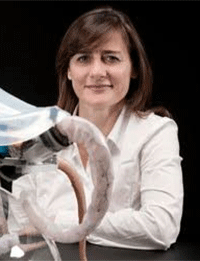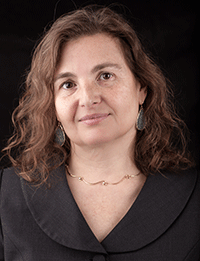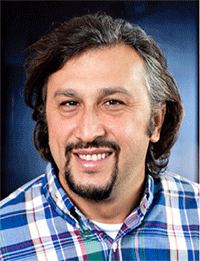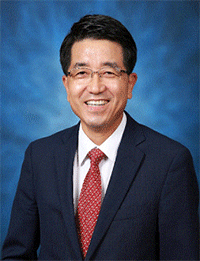|
 |
 |
| |
|
 |
| |
| |
| Cecilia Laschi |
| Scuola Superiore Sant'Anna, Italy
|
 |
Cecilia Laschi is Full Professor at the BioRobotics Institute of Scuola Superiore Sant'Anna in Pisa, Italy, where she serves as Rector’s delegate to Research. She graduated in Computer Science at the University of Pisa in 1993 and received the Ph.D. in Robotics from the University of Genoa in 1998. In 2001-2002 she was JSPS visiting researcher at Waseda University in Tokyo.
Her research interests are in the field of soft robotics, a young research area that she pioneered and contributed to develop at international level, including its applications in marine robotics and in the biomedical field. She has been working in humanoid robotics and neurorobotics, at the merge of neuroscience and robotics.
She is in the Editorial Boards of several international journals. She serves as reviewer for many journals, including Nature and Science, for the European Commission, including the ERC programme, and for many national research agencies.
She is senior member of the IEEE, of the Engineering in Medicine and Biology Society (EMBS), and of the Robotics & Automation Society (RAS), where she served as elected AdCom member and currently is Co-Chair of the TC on Soft Robotics. |
|
| |
| She founded and served as General Chair for the IEEE-RAS First International Conference on Soft Robotics in Livorno, in April 24-28, 2018.
She is founding member of RoboTech srl, spin-off company of the Scuola Superiore Sant’Anna, in the sector of edutainment robotics |
| |
| |
| |
|
 |
| |
| Daniela Rus |
| Professor, MIT, USA |
| |
| The digitization of practically everything coupled with the mobile Internet, the automation of knowledge work, and advanced robotics promises a future with democratized use of machines and wide-spread use of robots and customization. While the last 60 years have defined the field of industrial robots, and empowered hard bodied robots to execute complex assembly tasks in constrained industrial settings, the next 60 years will be ushering in our time with Pervasive robots that can help people with physical tasks. With the development of soft materials, machines and materials are coming closer together with machines becoming compliant and fluid like materials and materials becoming more intelligent and this raises interesting questions around the design, fabrication, and control of robots. In this talk I will discuss recent developments toward soft robots the role of computation in (1) on demand creation of robots, (2) making robots more capable of reasoning in the world, and (3) making more intuitive interfaces between robots and people. |
 |
Daniela Rus is the Andrew (1956) and Erna Viterbi Professor of Electrical Engineering and Computer Science and Director of the Computer Science and Artificial Intelligence Laboratory (CSAIL) at MIT. Rus’ research interests are in robotics, artificial intelligence, and data science.
The focus of her work is developing the science and engineering of autonomy, toward the long-term objective of enabling a future with machines pervasively integrated into the fabric of life, supporting people with cognitive and physical tasks. Her research addresses some of the gaps between where robots are today and the promise of pervasive robots: increasing the ability of machines to reason, learn, and adapt to complex tasks in human-centered environments, developing intuitive interfaces between robots and people, and creating the tools for designing and fabricating new robots quickly and efficiently. The applications of this work are broad and include transportation, manufacturing, agriculture, construction, monitoring the environment, underwater exploration, smart cities, medicine, and in-home tasks such as cooking. |
|
| |
| Rus serves as the Associate Director of MIT’s Quest for Intelligence Core, and as Director of the Toyota-CSAIL Joint Research Center, whose focus is the advancement of AI research and its applications to intelligent vehicles. She is a member of the Toyota Research Institute advisory board.
Rus is a Class of 2002 MacArthur Fellow, a fellow of ACM, AAAI and IEEE, and a member of the National Academy of Engineering and the American Academy of Arts and Sciences. She is the recipient of the 2017 Engelberger Robotics Award from the Robotics Industries Association. She earned her PhD in Computer Science from Cornell University. |
| |
| |
|
| |
 |
| |
| Metin Sitti |
| Professor, Max Planck Institute for Intelligent Systems, Germany |
Inspired by soft-bodied animals, soft functional active materials could enable physical intelligence for small-scale (from a few millimeters down to a few micrometers overall size) robots by providing them unique capabilities, such as shape changing and programming, physical adaptation, safe interaction with their environment, and multi-functional and drastically diverse dynamics. In this talk, our recent activities on design, manufacturing, and control of new bio-inspired shape-programmable active soft matter and untethered soft robots at the milli/microscale are reported. Untethered soft millirobots inspired by spermatozoids, caterpillars, and jellyfishes are proposed using elastomeric magnetic composite materials. Static and dynamic shapes of such magnetic active soft materials are programmed using a computational design methodology. These soft robots are demonstrated to be able to have seven or more locomotion modalities (undulatory swimming, jellyfish-like swimming, water meniscus climbing, jumping, ground walking, rolling, crawling inside constrained environments, etc.) in a single robot for the first time to be able to move on complex environments, such as inside the human body. Preliminary ultrasound-guided navigation of such soft robots is presented inside an ex vivo tissue towards their medical applications to deliver drugs and other cargo locally and heat the local tissues for hyperthermia and cauterization. Next, a more specialized soft-bodied jellyfish-inspired milliswimmer is shown to realize multiple functionalities by producing diverse controlled fluidic flows around its body using its magnetic composite elastomer lappets bent by remote magnetic fields. This jellyfish robot can conduct four different robotic tasks: selectively trap and transport objects of two different sizes, burrow into granular media consisting of fine beads to either camouflage or search a target object, enhance the local mixing of two different chemicals, and generate a desired concentrated chemical path. |
 |
Metin Sitti received the BSc and MSc degrees in electrical and electronics engineering from Boğaziçi University, Istanbul, Turkey, in 1992 and 1994, respectively, and the PhD degree in electrical engineering from the University of Tokyo, Tokyo, Japan, in 1999. He was a research scientist at University of California at Berkeley, USA during 1999-2002 and a professor in Department of Mechanical Engineering and Robotics Institute at Carnegie Mellon University, USA during 2002-2016. Since 2014, he has been the director of the Physical Intelligence Department at the Max Planck Institute for Intelligent Systems in Stuttgart, Germany. His research interests include small-scale physical intelligence, mobile milli/microrobots, bio-inspiration, advanced soft functional materials, and untethered soft medical devices. He is an IEEE Fellow. He received the Rahmi Koç Science Prize in 2018, SPIE Nanoengineering Pioneer Award in 2011, and NSF CAREER Award in 2005. He received many best paper and video awards in major conferences. He is the editor-in-chief of Progress in Biomedical Engineering and Journal of Micro-Bio Robotics, associate editor in Extreme Mechanics Letters and Biomimetics & Bioinspiration, and an editorial board member in Advanced Material Technologies and Advanced Intelligent Systems journals.
|
|
| |
| |
| |
|
 |
| |
| Taeghwan Hyeon |
| Professor, Seoul National University, Korea |
| |
In this talk, I will present recent advances on the fabrication of ultraflexible and/or stretchable electronic and optoelectronic devices integrated with various functional nanomaterials and their applications to wearable and implantable medical and healthcare devices. We reported graphene-hybrid electrochemical devices integrated with thermo-responsive micro-needles for the sweat-based diabetes monitoring and feedback therapy. We also developed a wearable/disposable sweat-based glucose monitoring strip-type device integrated with a multi-stage controlled feedback transdermal drug delivery module for a novel closed-loop solution for the noninvasive diabetes treatment. We reported the designed fabrication of multifunctional wearable electronic devices for sensing, data storage, and drug-based feedback therapy of motion-related neurological disorders such as Parkinson’s disease.
We introduced electromechanical cardioplasty using an epicardial mesh made of electrically conductive and mechanically elastic Ag nanowire-rubber nanocomposite to resemble the innate cardiac tissue and confer cardiac conduction system function. We developed a highly conductive, biocompatible, and soft nanocomposite composed of silver-gold (Ag-Au) core-sheath nanowires and polystyrene-butadiene-styrene (SBS) elastomer for a wearable device for recording electrophysiological signals through the human skin and delivering electrical and thermal stimulations that respond to the sensor signals.
We reported the first successful demonstration of a wearable red-green-blue (RGB) colloidal quantum dot light-emitting diode (QD LED) array with resolution up to 2,460 pixels per inch using a novel intaglio transfer printing technique. We also reported transparent QD LEDs with extremely high luminance (73,000 cd∙m–2 at 9 V) and transmittance (90% at 550 nm, 84% over visible range). |
 |
Taeghwan Hyeon received his B. S. (1987) and M. S. (1989) in Chemistry from Seoul National University (SNU), Korea. He obtained his Ph.D. in Chemistry from U. Illinois (1996). Since he joined the faculty of the School of Chemical and Biological Engineering of Seoul National University in September 1997, he has focused on the synthesis and applications of uniform-sized nanoparticles and related nanostructured materials, and published > 350 papers in prominent international journals (~ 50,000 citations and h-index of ~ 120). He is a SNU Distinguished Professor. In 2011, he was selected as “Top 100 Chemists” of the decade by UNESCO&IUPAC. For the last > 5 years, he has chosen as “Highly Cited Researcher” in Chemistry and Materials Science areas by Clarivate Analytics. Since 2012, he has been serving as a Director of Center for Nanoparticle Research of Institute for Basic Science (IBS). He is Fellow of Royal Society of Chemistry (RSC) and Materials Research Society (MRS). |
|
| |
| He received many awards including the Korea S&T Award from the Korean President (2016), Hoam Prize (2012, Samsung Hoam Foundation), POSCO-T. J. Park Award (2008), and the IUVSTA Prize for Technology (International Union for Vacuum Science, Technique and Applications, 2016). Since 2010, he has served as an Associate Editor of J. Am. Chem. Soc. He has been serving as editorial (advisory) board members of ACS Central Science, Advanced Materials, Nano Today, and Small. |
|
| |
| |
| |
| |
| |
| |
| |
| |
| |
|
|
|
